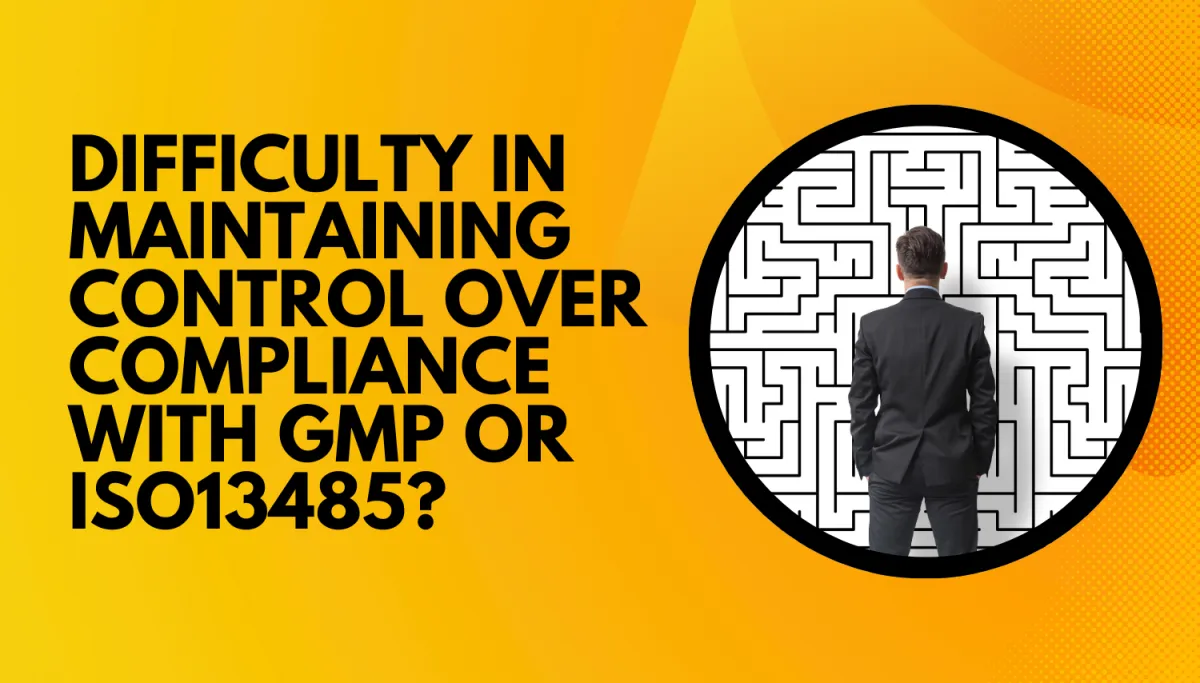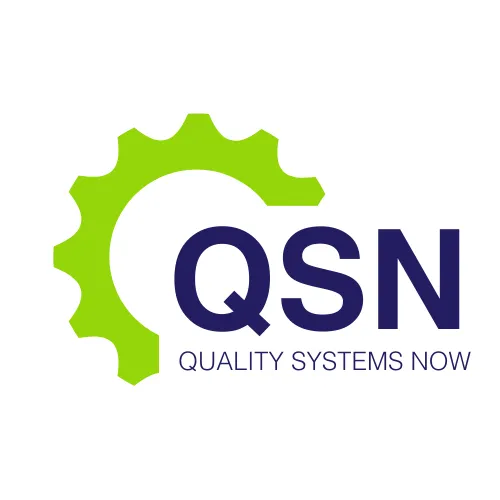LATEST NEWS

Difficulty in maintaining control over compliance with GMP or ISO13485?
In pharmaceuticals, medical devices, and biotechnology, maintaining compliance with Good Manufacturing Practices (GMP) and ISO 13485 standards is not just a regulatory requirement but a critical component of operational integrity. These standards are designed to ensure that products are consistently produced and controlled according to quality standards. However, the complexity of these regulations, coupled with the dynamic nature of these industries, makes maintaining control over compliance a formidable challenge.
Did you know that at Quality Systems Now it is these challenges that we specialise in solving for our clients? Leverage our knowhow to further your organisational goals.
Understanding the Importance of GMP and ISO 13485 Compliance
Before delving into the challenges, it's essential to understand why GMP and ISO 13485 compliance is so crucial. GMP, a system that ensures products are consistently produced and controlled according to quality standards, is fundamental in safeguarding public health. It covers all aspects of production, from the raw materials, premises, and equipment to the training and hygiene of staff. Failure to comply with GMP can lead to severe consequences, including product recalls, legal action, and damage to a company’s reputation.
ISO 13485, on the other hand, is an international standard that specifies requirements for a quality management system (QMS) specific to the medical devices industry. It ensures that medical devices meet customer and regulatory requirements. Compliance with ISO 13485 is not just about meeting regulatory obligations; it’s about ensuring the safety and effectiveness of medical devices, which directly impacts patient safety.
The Challenges of Maintaining GMP and ISO 13485 Compliance
Regulatory Complexity and Changes
One of the primary challenges in maintaining control over GMP and ISO 13485 compliance is the ever-evolving nature of regulatory requirements. Regulatory bodies, such as the FDA (Food and Drug Administration) and the European Medicines Agency (EMA), frequently update guidelines to keep pace with technological advancements and emerging risks. Keeping up with these changes requires constant vigilance and a proactive approach to regulatory intelligence.
For example, the transition from ISO 13485:2003 to ISO 13485:2016 introduced significant changes, including a greater emphasis on risk management and supplier control. Companies that failed to adequately prepare for these changes faced difficulties in maintaining compliance, often resulting in costly audits and remediation efforts.
Globalization of Supply Chains
The globalization of supply chains adds another layer of complexity to GMP and ISO 13485 compliance. With manufacturing, sourcing, and distribution often spread across multiple countries, ensuring that every link in the supply chain adheres to the same stringent quality standards is a daunting task. Variability in regulatory enforcement across regions can lead to inconsistencies in compliance practices.
For instance, a medical device manufacturer might source components from multiple suppliers located in different countries, each with its own regulatory landscape. Ensuring that these suppliers meet GMP and ISO 13485 standards requires rigorous supplier qualification, continuous monitoring, and regular audits. The failure of a single supplier to comply can jeopardize the entire production process and lead to non-compliance.
Documentation and Record-Keeping
Both GMP and ISO 13485 require extensive documentation and record-keeping to demonstrate compliance. This includes everything from standard operating procedures (SOPs) and batch records to quality control tests and audit reports. Maintaining accurate and up-to-date documentation is critical, as any discrepancies can be viewed as non-compliance during an audit.
However, the sheer volume of documentation required can be overwhelming, particularly for organizations with complex operations or those undergoing rapid growth. Manual processes, in particular, are prone to errors, duplication, and omissions, all of which can compromise compliance. Moreover, the shift towards digital records and electronic quality management systems (eQMS) introduces its own set of challenges, including data integrity and cybersecurity risks.
Human Factors and Training
Human error is a significant factor in compliance failures. Inadequate training, lack of awareness, and insufficient communication can all contribute to lapses in GMP and ISO 13485 compliance. Employees who are not adequately trained in the requirements of these standards may inadvertently deviate from established procedures, leading to non-compliance.
Moreover, maintaining a consistent level of training across a global workforce is challenging, especially for organizations with high employee turnover or those operating in regions with varying levels of regulatory expertise. Ensuring that all employees, from senior management to line workers, understand their roles and responsibilities in maintaining compliance is crucial.
Risk Management and Control
Both GMP and ISO 13485 place a strong emphasis on risk management, requiring organizations to identify, assess, and mitigate risks throughout the product lifecycle. However, implementing a robust risk management process is easier said than done. It requires a thorough understanding of potential risks, both internal and external, and the ability to anticipate and respond to them proactively.
For instance, in the medical devices industry, risk management extends beyond the manufacturing process to include post-market surveillance, where companies must monitor the performance of their products in the real world and take corrective actions if necessary. The challenge lies in integrating risk management into the overall quality management system and ensuring that it is not treated as a standalone activity.
Continuous Improvement
Compliance with GMP and ISO 13485 is not a one-time achievement but an ongoing process. Organizations must continually assess their processes, identify areas for improvement, and implement corrective and preventive actions (CAPAs) to maintain compliance. However, fostering a culture of continuous improvement can be challenging, particularly in organizations where compliance is viewed as a regulatory burden rather than a business opportunity.
Continuous improvement requires a proactive mindset, where employees at all levels are encouraged to identify potential issues and suggest improvements. It also requires effective communication and collaboration across departments, as well as the use of tools and methodologies, such as Lean and Six Sigma, to drive process improvements.
Strategies for Overcoming Compliance Challenges
Given the complexity of maintaining GMP and ISO 13485 compliance, organizations must adopt a strategic approach to overcome these challenges. Here are some key strategies:
Invest in Regulatory Intelligence
Staying ahead of regulatory changes is crucial for maintaining compliance. Organizations should invest in regulatory intelligence tools and resources that provide real-time updates on changes to GMP and ISO 13485 standards. Regularly engaging with regulatory experts and participating in industry forums can also help organizations anticipate and prepare for upcoming changes.
Implement an Integrated Quality Management System
An integrated quality management system (QMS) that aligns with both GMP and ISO 13485 requirements can help streamline compliance efforts. An effective QMS should include automated workflows, centralized documentation management, and real-time monitoring of compliance metrics. This not only reduces the risk of errors but also improves the organization’s ability to respond quickly to compliance issues.
Strengthen Supplier Management
Given the global nature of supply chains, robust supplier management is essential for maintaining compliance. Organizations should implement a rigorous supplier qualification process, conduct regular audits, and establish clear communication channels with suppliers. Additionally, using performance metrics to continuously evaluate supplier compliance can help identify and address issues before they escalate.
Enhance Training and Awareness
Investing in comprehensive training programs is essential for building a culture of compliance. Training should be tailored to the specific roles and responsibilities of employees and include real-life scenarios and case studies. Regular refresher courses and ongoing communication about the importance of compliance can help reinforce this culture.
Embed Risk Management into the QMS
To effectively manage risks, organizations should integrate risk management into their overall QMS. This includes using risk-based approaches to process management, conducting regular risk assessments, and implementing CAPAs to address identified risks. Ensuring that risk management is a continuous process, rather than a one-time activity, is key to maintaining compliance.
Foster a Culture of Continuous Improvement
Continuous improvement should be embedded into the organization’s culture, with employees at all levels encouraged to identify and suggest improvements. Regularly reviewing processes, conducting internal audits, and using methodologies such as Lean and Six Sigma can help drive ongoing improvements and maintain compliance.
Let's Talk about it - book your consultation
Maintaining control over GMP and ISO 13485 compliance is undoubtedly challenging, given the complexity of the regulations, the global nature of supply chains, and the need for continuous improvement. However, by adopting a strategic approach that includes regulatory intelligence, an integrated QMS, strong supplier management, comprehensive training, risk management, and a culture of continuous improvement, organizations can overcome these challenges and ensure that they remain compliant. In doing so, they not only protect themselves from regulatory risks but also create a foundation for sustainable growth and innovation.
